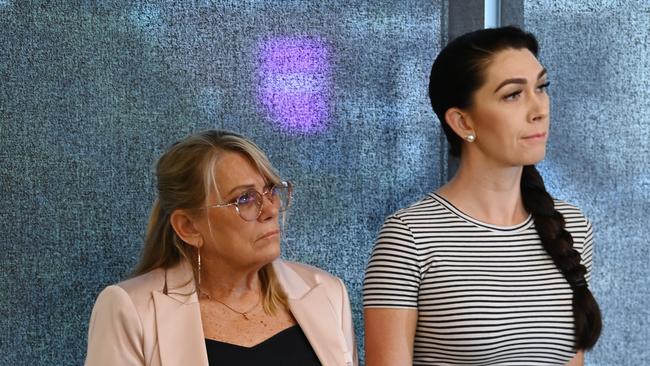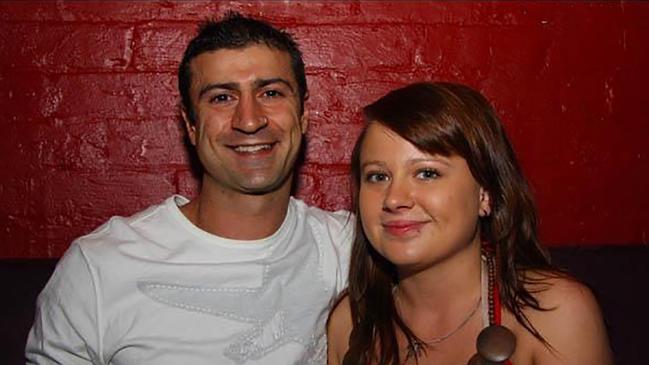DNA lab chief Linzi Wilson-Wilde in the spotlight over what she left out of report
A cloud has been cast over the new expert in charge of rebuilding and restoring confidence in Queensland’s DNA lab, as doubts are raised about results in thousands more serious crimes than previously thought.

Did the woman who is now the most powerful scientist in Queensland, running a strife-torn lab that was brought to its knees, mislead the commission of inquiry that last year identified a corrupt culture in testing the state’s thousands of DNA samples a year?
This is the question that potentially arises out of disturbing new claims about the lab that has the crucial role of providing evidence relied on by police, prosecutors, defence lawyers, judges and, most important, victims of crime.
New allegations by independent forensic biologist Kirsty Wright in this newspaper have raised doubts about thousands more DNA results in serious crimes than previously thought, casting a cloud over the new chief of the lab, Linzi Wilson-Wilde.
This is research Wright has conducted since retired judge Walter Sofronoff’s inquiry ended, and which escaped the attention of the inquiry.
Wright has discovered a flawed DNA extraction method used in the investigation into the vicious stabbing murder of Shandee Blackburn in 2013 was failing even before its introduction in 2007, and may have resulted in crucial evidence being missed in crimes for nine years.
Wright says it’s the key flaw that may explain why Blackburn’s killer was never identified, and that it’s crucial knowledge for solving many other crimes.
It’s a blow for Wilson-Wilde because the highly regarded new chief of the lab was engaged last year as an expert by Sofronoff’s landmark forensics inquiry to examine the initial use of the automated DNA extraction method, and failed in her report to detail serious problems she now says she was aware of.
Trials of the new method in a misleading verification report examined by Wilson-Wilde had found it was recovering up to 92 per cent less DNA than a manual method, but it was still introduced because of speed efficiencies.
By not including in her report this catastrophic issue, Wilson-Wilde did not raise what Wright says is the most alarming part of the whole lab debacle and the root cause of the failures in the Blackburn investigation.
Wilson-Wilde has several explanations: She was commissioned to look into a separate contamination issue and was focused on that; she thought the problems with the extraction method would have been resolved because of the addition of a manual step; she raised the issue in briefings with lawyers assisting the inquiry; she had a very tight deadline and was under pressure while managing South Australian forensics full time; and she knew other eminent scientists were working on that general issue.
Following is one of the exchanges in recent weeks between this newspaper and Wilson-Wilde, whose recruitment into the top role was widely praised.
Question: “Do you think, though, the inquiry would have expected you to say, ‘Hey, there’s also this massive yield problem, you might want to start looking at that because it looks pretty serious’?”
Wilson-Wilde: “I wasn’t asked to look at a yield issue at all.”
Question: “Okay, but isn’t that something you’d just want to volunteer anyway? Like, let them know because they don’t know what’s there until the expert witness tells them?”
Wilson-Wilde: “In my experience, part of that yield issue would have been addressed … And I already knew that we’re looking at DNA yield as an issue. So I wasn’t adding anything to the commission of inquiry by raising DNA yield as an issue because they were already looking at it.”
These answers raise only more questions for Wright, whose investigations into the lab with The Australian’s podcast Shandee’s Story led to the Sofronoff inquiry.
Wright is on the record as being fully supportive of Wilson-Wilde when she was appointed but now regretfully holds serious reservations.

“I was just delighted. I just felt like a weight had been lifted off my shoulders,” Wright recalls of Wilson-Wilde’s recruitment. “And it really does upset me to say this; seeing her failure to disclose this really important information, I now have serious concerns. It raises some extremely serious questions.”
One of the central issues raised by Wright in Shandee’s Story was that crime scene samples were failing to yield DNA profiles when they would have been expected to.
The Sofronoff inquiry engaged two pre-eminent international scientists, Bruce Budowle and Jo Veth, to look into it, along with Wright.
In the final week of the inquiry, just two days before they were to give evidence, Wright, Veth and Budowle stumbled across the possible answer to the DNA testing results in Blackburn’s case.
They discovered that at the time of Blackburn’s murder the lab had serious problems with an automated method of extracting DNA from crime scene samples.
Across a year’s worth of data from the lab’s cases in 2012-13, this method recovered four times less DNA than another method used in the lab, Wright says.
There were obvious implications not just for Blackburn’s case but for many thousands of criminal cases that had relied on variations of the automated method before it was discontinued in 2016. For the Blackburn investigation, the comparatively poor method of DNA extraction was used on 46 samples of concern that featured heavily in the Shandee’s Story podcast.
One of these was from a fresh pool of blood that returned a result of “no DNA detected” when it should have been a rich source of DNA. The same extraction method was used on 12 samples from suspect John Peros’s car that tested presumptively positive to blood and that a police scientific officer labelled as blood, but that later returned results of “no DNA detected”. Peros denies any involvement in the murder.

Samples from Blackburn’s clothing and fingernails, and from a “bloodied” knife handed in to police, were also processed using the same extraction method and returned no DNA.
The late discovery of the problems with the extraction method offered an explanation, but the inquiry was on a tight deadline and time had run out.
Sofronoff at that point already had all he needed from other shocking issues to detonate the lab and start afresh.
In his 500-page report, he recommended the lab find out how long the extraction method was performing sub-optimally, and if there could be retesting.
Wright did her own digging and found a disturbing 2008 scientific report. It was on Project 13, the lab’s effort to test the automated method before it was introduced the previous year.
Wilson-Wilde examined the Project 13 report last year in her role as an expert witness for the inquiry, when she was asked to look into the extraction method because it was known to have caused cross-contamination of samples.
That cross-contamination resulted in a sexual assault complainant being wrongly questioned over an unrelated murder, according to the evidence of one scientist.
There was no mention in Wilson-Wilde’s report to the inquiry that the Project 13 report had a plainly false abstract, or executive summary, that appeared designed to mislead anyone reading it.
The summary stated that tests on the automated method Wilson-Wilde was reviewing delivered results that were “comparable” with a manual method, and recommended its use.

Yet the graphs in the body of the report showed the automated method recovered up to 92 per cent less DNA than the manual method and was 100 times less sensitive.
If Wilson-Wilde did raise any of this with the lawyers assisting Sofronoff, it wasn’t mentioned in counsel assisting Susan Hedge’s summary at the inquiry of the expert’s findings.
“There’s no concern about the reliability of results produced by the laboratory in that period,” Hedge told the inquiry.
And although Wilson-Wilde was engaged as an expert because of the contamination issues, she was given a broad brief by the inquiry to determine, among other things, whether the testing process “was scientifically sound and conducted in accordance with international best practice”.
Wright said: “It’s obvious that the method that they introduced was failing to recover DNA on a very, very large scale. It jumps out very obviously in full graphs.
“Why was the lab failing to get DNA profiles? That was the heart of why the inquiry was set up. And the answer’s in that Project 13.
“So that should have been disclosed to the inquiry as a priority with exclamation marks.
“This was the most important finding, in my opinion, in the whole inquiry and potentially has a huge impact on many thousands of victims.”
Without the discovery, the lab could not have proceeded with appropriate testing in affected cases, Wright said.
“If those samples are simply retested, they’ll fail. You need to work out exactly what’s gone wrong at a molecular level,” she said.
Wilson-Wilde was asked by this newspaper whether she realised at the time of her review for the inquiry that the Project 13 report’s abstract was false and misleading.
“I thought the whole report was flawed. I thought the abstract was flawed, I thought the title was flawed, I thought the empirical study design was flawed,” she replied. “I thought a number of the statements in the report weren’t consistent with the data that was provided in the report.
“The automated method clearly wasn’t comparable to the manual method.”
She had called out the entire project being scientifically invalid, she insisted.
But in her actual report, she does not address the critical yield issue or the false claims in the abstract that she is now calling out. Her report, with its milder observations that verification was insufficient and not consistent with expected good practice, sank almost without trace at the inquiry.
Wright says she was initially hoodwinked by the Project 13 report’s fraudulent summary, and only later read it fully and realised the automated extraction method was failing before it was introduced.
The timesaving method involved using robots to extract DNA, rather than scientists doing it by hand.
It was a godsend for the lab because its political masters had promised to completely eradicate testing delays and backlogs that were generating fierce criticism from the courts and public.
“I believe that the failure to identify Shandee’s murderer can be traced back to Project 13,” Wright says. “You don’t even have to be a scientist, to look at this data, to look at Project 13, and see that this method absolutely should never be used on crime scene evidence. It was a certainty to fail.”
Wright says she has carefully reviewed documents and data published by the inquiry and believes changes to the DNA extraction method after its initial launch had minimal effect.
The method was “still clearly failing”, she says.
“If Dr Bruce Budowle, Jo Veth and myself didn’t pick up the failure of that method in 2013, and we only stumbled across that two days before we provided testimony, that could have severely impacted Shandee’s case,” Wright says.
“It would have meant that her samples wouldn’t have been properly retested, and it meant that even if they were retested, they probably would have failed because no one would have known what had gone wrong with Project 13.
“It may have affected the coronial investigation and I think it very, very likely would have prevented any chance of identifying the offender.”
It’s the first big test for a new advisory board overseeing the lab, chaired by Sofronoff and retired District Court judge and criminal law expert Julie Dick.
In an ABC radio interview in June, Sofronoff said one of the reasons for the board was that DNA was such a difficult subject to understand and “when problems arise there’s nobody that insiders, scientists, can go to”.
Here, an independent scientist, Wright, is raising serious concerns about information that was not canvassed at the inquiry and that directly impacts on the new executive in charge of the lab.





